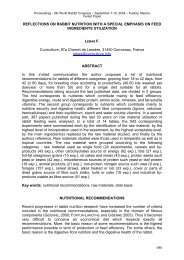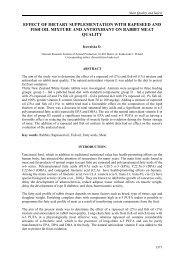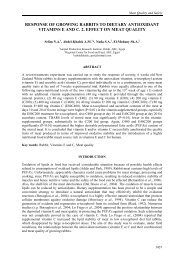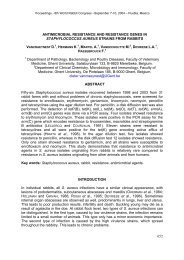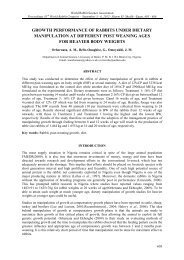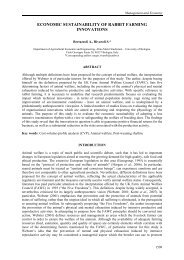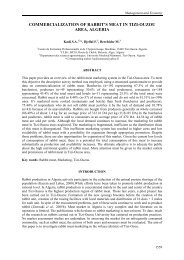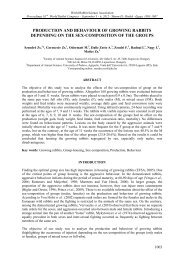efficacy of ciprofloxacin and enrofloxacin in the - World Rabbit ...
efficacy of ciprofloxacin and enrofloxacin in the - World Rabbit ...
efficacy of ciprofloxacin and enrofloxacin in the - World Rabbit ...
You also want an ePaper? Increase the reach of your titles
YUMPU automatically turns print PDFs into web optimized ePapers that Google loves.
Proceed<strong>in</strong>gs - 8th <strong>World</strong> <strong>Rabbit</strong> Congress –September 7-10, 2004 – Puebla, Mexico<br />
EFFICACY OF CIPROFLOXACIN AND ENROFLOXACIN IN THE TREATMENT OF A<br />
RESPIRATORY PASTEURELLOSIS OUTBREAK IN NEW ZEALAND RABBITS<br />
VELÁZQUEZ O. V., ALONSO F. M. U., MENDOZA B. J., TALAVERA R. M., LAGUNAS B. S.,<br />
MONTES DE OCA J. R.<br />
Centro de Investigación y Estudios Avanzados en Salud Animal, Facultad de Medic<strong>in</strong>a<br />
Veter<strong>in</strong>aria y Zootecnia, Universidad Autónoma del Estado de México. Km. 15.5<br />
Carretera Toluca-Atlacomulco, México, C.P. 50200<br />
vvo@uaemex.mx<br />
ABSTRACT<br />
Pasteurelosis is an important economic disease <strong>in</strong> rabbit production. The objective <strong>of</strong><br />
this study was to determ<strong>in</strong>e <strong>the</strong> <strong>in</strong>dividual <strong>the</strong>rapeutic <strong>efficacy</strong> <strong>of</strong> fluoroqu<strong>in</strong>olones such<br />
as cipr<strong>of</strong>loxac<strong>in</strong> <strong>and</strong> enr<strong>of</strong>loxac<strong>in</strong> on Pasteurella multocida <strong>in</strong> one outbreak <strong>of</strong> respiratory<br />
pasteurellosis <strong>in</strong> a New Zeal<strong>and</strong> rabbit farm <strong>in</strong> central Mexico. The drugs were<br />
adm<strong>in</strong>istrated subcutaneously dur<strong>in</strong>g three days <strong>in</strong> animal groups: A cipr<strong>of</strong>loxac<strong>in</strong><br />
20/mg/kg b. wt.; B enr<strong>of</strong>loxac<strong>in</strong> 10/mg/k b. wt.; C receiv<strong>in</strong>g a placebo 1 mL/k b. wt.; D<br />
untreated animals. The <strong>efficacy</strong> was evaluated as disease recovery <strong>and</strong> mortality<br />
reduction after treatment. Pasteurella multocida A3 was isolated from cl<strong>in</strong>ical cases <strong>and</strong><br />
postmortem exam<strong>in</strong>ation from acute or chronic lesions. The rabbit survival <strong>in</strong> groups A<br />
<strong>and</strong> C was higher with low mortality compared with untreated animals <strong>in</strong> which <strong>the</strong><br />
cl<strong>in</strong>ical s<strong>in</strong>gs were persistent. Pathological f<strong>in</strong>d<strong>in</strong>gs related to <strong>the</strong> <strong>in</strong>fection <strong>in</strong>volved<br />
abscedative pneumonia <strong>and</strong> pleuritis <strong>and</strong> extrapulmonary lesions such as otitis,<br />
men<strong>in</strong>goencephalitis <strong>and</strong> subcutaneous abscesses. Our results <strong>in</strong>dicate that<br />
cipr<strong>of</strong>loxac<strong>in</strong> <strong>and</strong> enr<strong>of</strong>loxac<strong>in</strong> are efficient as medical treatment <strong>of</strong> acute respiratory<br />
pasteurellosis <strong>in</strong> young rabbits, reduc<strong>in</strong>g <strong>the</strong> cl<strong>in</strong>ical cases <strong>and</strong> lesion severity <strong>and</strong><br />
<strong>in</strong>creas<strong>in</strong>g survival <strong>in</strong> animals.<br />
Key words: rabbits, pasteurellosis, cipr<strong>of</strong>loxac<strong>in</strong> , enr<strong>of</strong>loxac<strong>in</strong>, pathological f<strong>in</strong>d<strong>in</strong>gs.<br />
INTRODUCTION<br />
Pasteurella multocida is an important bacterial pathogen <strong>in</strong> rabbit production. Outbreaks<br />
are caused by environmental changes, stress or it is associated to o<strong>the</strong>r illnesses.<br />
Bordetella bronchiseptica, Staphylococcus aureus <strong>and</strong> Streptococci are commonly<br />
associated to P. multocida <strong>in</strong>fection (GOLDSTEIN et al., 1997).<br />
The adherence to respiratory epi<strong>the</strong>lium <strong>and</strong> <strong>the</strong> ability to resist phagocytosis as well as<br />
<strong>in</strong>tracellular kill<strong>in</strong>g by neutrophils may be present <strong>in</strong> serotypes <strong>in</strong>clud<strong>in</strong>g 12:A, 3:D, <strong>and</strong><br />
3:A. The degeneration <strong>of</strong> <strong>the</strong> nasal turb<strong>in</strong>ates has been associated with tox<strong>in</strong>-production<br />
<strong>in</strong> rabbits <strong>in</strong>fected with capsular types D <strong>and</strong> A (DIGIACOMO et al.,1989; DEEB et<br />
al.,1990).<br />
658
Proceed<strong>in</strong>gs - 8th <strong>World</strong> <strong>Rabbit</strong> Congress –September 7-10, 2004 – Puebla, Mexico<br />
Pasteurelosis is a persistent disease <strong>in</strong> most rabbit hutches. The cl<strong>in</strong>ical cases <strong>in</strong> animal<br />
population occurs <strong>in</strong> acute <strong>and</strong> chronic presentations associated to septicaemia,<br />
pneumonia, men<strong>in</strong>goencephalitis, otitis, reproductive failures <strong>and</strong> located abscesses<br />
(DIGIACOMO et al.,1989; KUNSTYR <strong>and</strong> NAUMANN, 1985; SUCKOW et al., 1991;RICHARDSON<br />
et al., 1997).<br />
Antibiotics treatment <strong>in</strong> affected animals reduce <strong>the</strong> number <strong>of</strong> cl<strong>in</strong>ical cases as well as<br />
<strong>the</strong> economic impact (LION et al., 1996). Antibacterial activity <strong>of</strong> fluoroqu<strong>in</strong>olones have<br />
shown a broad spectrum <strong>of</strong> activity aga<strong>in</strong>st gramnegative <strong>and</strong> grampositive bacteria.<br />
The post-antibiotic effect is considered as an additional <strong>the</strong>rapeutic benefit (SPRENG et<br />
al., 1995). In vitro sensitivity tests <strong>in</strong>dicate <strong>the</strong> activity <strong>of</strong> cipr<strong>of</strong>loxac<strong>in</strong> <strong>and</strong> enr<strong>of</strong>loxac<strong>in</strong><br />
on Pasteurella multocida (GOLDSTEIN et al., 1997 ; HANAN et al., 2000).<br />
The objective <strong>of</strong> this study was to determ<strong>in</strong>e <strong>the</strong> <strong>in</strong>dividual <strong>the</strong>rapeutic effect <strong>of</strong> two<br />
fluoroqu<strong>in</strong>olones, cipr<strong>of</strong>loxac<strong>in</strong> <strong>and</strong> enr<strong>of</strong>loxac<strong>in</strong> on Pasteurella multocida <strong>in</strong> one<br />
outbreak <strong>of</strong> Pasteurellosis occurred <strong>in</strong> a New Zeal<strong>and</strong> rabbit farm <strong>in</strong> central Mexico.<br />
MATERIAL AND METHODS<br />
Animal farm<br />
Dur<strong>in</strong>g <strong>the</strong> dry season <strong>in</strong> w<strong>in</strong>ter time (November 2002), <strong>in</strong> <strong>the</strong> Nor<strong>the</strong>rn region <strong>of</strong> <strong>the</strong><br />
state <strong>of</strong> Mexico, a commercial breeder New Zeal<strong>and</strong> rabbit hutch located 19º47´27´´<br />
North latitude was highly affected by Pasteurella multocida <strong>in</strong>fection <strong>in</strong> an acute<br />
respiratory form, with a morbidity rate <strong>of</strong> 85% estimated from a 3700 total animal<br />
population.<br />
200 rabbits were r<strong>and</strong>omly selected <strong>in</strong> <strong>the</strong> same proportion <strong>of</strong> females <strong>and</strong> males ag<strong>in</strong>g<br />
ten to twelve weeks. They were not medicated animals which suffered <strong>the</strong> cl<strong>in</strong>ical<br />
disease characterized by fever, eyes redness, conjunctivae secretion with predom<strong>in</strong>ant<br />
respiratory signs; sneez<strong>in</strong>g, cough<strong>in</strong>g, nasal discharge as well as acute pneumonia<br />
manifestations.<br />
Experimental groups<br />
The experimental cl<strong>in</strong>ically affected animals, were distributed <strong>in</strong> four groups <strong>of</strong> 50<br />
animals each from <strong>the</strong> husb<strong>and</strong>ry <strong>and</strong> ma<strong>in</strong>ta<strong>in</strong>ed <strong>in</strong> isolated conditions out <strong>of</strong> <strong>the</strong> farm.<br />
The treatment was given with two fluoroqu<strong>in</strong>olones subcutaneously adm<strong>in</strong>istrated for<br />
three days with <strong>the</strong> follow<strong>in</strong>g treatments: group A cipr<strong>of</strong>loxac<strong>in</strong>* (CPX) 20/mg/kg b. wt<br />
(*Primec<strong>in</strong>, Lapisa, México)., group B enr<strong>of</strong>loxac<strong>in</strong>**(ERF) 10/mg/k b.wt.(** Pir<strong>of</strong>lox, Pisa<br />
Agropecuaria, México) , group C receiv<strong>in</strong>g a placebo physiologic sal<strong>in</strong>e solution (PSS) 1<br />
/mL/k b. wt., <strong>and</strong> <strong>the</strong> fourth group D was affected but not treated dur<strong>in</strong>g <strong>the</strong><br />
experimental period. After <strong>the</strong> drug medication period (seven days later) ten rabbits <strong>of</strong><br />
each group were euthanized <strong>and</strong> sampled for bacteriology <strong>and</strong> pathological rout<strong>in</strong>ary<br />
procedures. The rest <strong>of</strong> <strong>the</strong> animals were observed for twenty one days until <strong>the</strong><br />
remission <strong>of</strong> cl<strong>in</strong>ical signs.<br />
659
Proceed<strong>in</strong>gs - 8th <strong>World</strong> <strong>Rabbit</strong> Congress –September 7-10, 2004 – Puebla, Mexico<br />
Laboratory procedures <strong>and</strong> cl<strong>in</strong>ical f<strong>in</strong>d<strong>in</strong>gs<br />
The postmortem exam<strong>in</strong>ation was conducted by evaluation <strong>of</strong> <strong>the</strong> severity lesions as<br />
well as <strong>the</strong> lungs distribution <strong>and</strong> o<strong>the</strong>r lesions <strong>in</strong> organs. The pathologic category <strong>in</strong><br />
lungs were considered as follows: C0 none macroscopic f<strong>in</strong>d<strong>in</strong>gs <strong>of</strong> pneumonia lesions;<br />
C1 light lesions occurr<strong>in</strong>g <strong>in</strong> < 10% <strong>of</strong> <strong>the</strong> lung with a non progressive process; C2 15 to<br />
25 % affected lung surface; C3 > 30% lung area <strong>in</strong>clud<strong>in</strong>g o<strong>the</strong>r thoracic lesions <strong>and</strong>/or<br />
extra pulmonary affections. Bacteriological diagnosis <strong>of</strong> <strong>the</strong> necropsy cases were made<br />
from samples <strong>in</strong> affected organs by <strong>in</strong>oculat<strong>in</strong>g blood agar slops <strong>and</strong> cultur<strong>in</strong>g at 37ºC<br />
for 18 to 24 h.<br />
The isolates <strong>of</strong> Pasteurella multocida were identified by Gram sta<strong>in</strong><strong>in</strong>g, biochemical<br />
tests, motility <strong>and</strong> haemolytic activity. The cl<strong>in</strong>ical signs <strong>and</strong> mortality were registered<br />
from all <strong>the</strong> groups.<br />
Statistical analysis<br />
The data were analyzed us<strong>in</strong>g <strong>the</strong> estimation proportions test, consider<strong>in</strong>g <strong>the</strong><br />
observations derived from <strong>the</strong> survival <strong>of</strong> <strong>the</strong> animal groups, cl<strong>in</strong>ical signs <strong>and</strong><br />
pathological f<strong>in</strong>d<strong>in</strong>gs as limit value (P
Proceed<strong>in</strong>gs - 8th <strong>World</strong> <strong>Rabbit</strong> Congress –September 7-10, 2004 – Puebla, Mexico<br />
The macrolide antibiotics is an alternative <strong>in</strong> emergency cases <strong>in</strong> which bacterial<br />
antibiotic resistance occurs <strong>in</strong> <strong>the</strong> upper <strong>and</strong> lower respiratory tract diseases, as well as<br />
<strong>in</strong> <strong>the</strong> same <strong>in</strong>fection <strong>in</strong> man follow<strong>in</strong>g animal bites (LION et al., 1996; GOLDSTEIN et al.,<br />
1997). Experimental Pasteurella multocida <strong>in</strong>fection studies on drug treatment <strong>in</strong> rabbits<br />
may be conducted <strong>in</strong> an adapted animal model (PAUSEN et al.,1992).<br />
Cl<strong>in</strong>ical signs <strong>of</strong> <strong>the</strong> treated <strong>and</strong> untreated diseased rabbits are shown <strong>in</strong> Table 2.<br />
Dyspnea, seromucous nasal discharge <strong>and</strong> cough were <strong>the</strong> predom<strong>in</strong>ant cl<strong>in</strong>ical<br />
manifestations. This signs are commonly observed <strong>in</strong> acute pasteurelosis outbreaks.<br />
O<strong>the</strong>r progressive neurological <strong>and</strong> torticollis may be present associated to otitis, acute<br />
men<strong>in</strong>goencephalomyelitis <strong>in</strong> chronically <strong>in</strong>fected animals with Pasteurella multocida<br />
(KUNSTYR <strong>and</strong> NAUMANN, 1985; KUNSTYR <strong>and</strong> NAUMANN, 1985) some <strong>of</strong> <strong>the</strong>se cases<br />
could be related with pasteurellosis <strong>and</strong> encephalitozoonosis (MURRAY et al., 1985).<br />
Table 2. Predom<strong>in</strong>ant Cl<strong>in</strong>ical Signs In Diseased Animals Groups<br />
Signs %<br />
Red eyes 25<br />
Sneeze 40<br />
Cough 15<br />
Nasal discharges/ mucous 50<br />
Dispnea 75<br />
Cianosis 8<br />
Torticolis 1<br />
Neurological 5<br />
Orquitis 1<br />
Nasal purulent discharge 35<br />
Subcutaneous abscess 9<br />
Pathological f<strong>in</strong>d<strong>in</strong>gs are shown <strong>in</strong> Table 3.<strong>and</strong> 4. All treated <strong>and</strong> untreated animal<br />
groups, number <strong>of</strong> deaths, conjunctivitis, rh<strong>in</strong>itis, bronchopneumoniae were common<br />
alterations present <strong>in</strong> <strong>the</strong> acute form <strong>of</strong> <strong>the</strong> disease. C1 <strong>and</strong> C2 pathology categories<br />
were observed (DEEB et al., 1990). Chronical lesions <strong>in</strong> affected rabbits were mostly<br />
observed <strong>in</strong> non medicated animals as a fibr<strong>in</strong>opurulent pneumonia, otitis,<br />
men<strong>in</strong>ghoencephalitis <strong>and</strong> subcutaneouos abcesesses as a C3 category <strong>in</strong> <strong>the</strong><br />
postmortem study (KUNSTYR <strong>and</strong> NAUMANN, 1985; MURRAY et al., 1985).<br />
About 30 % had concurrent <strong>in</strong>fection <strong>of</strong> <strong>the</strong> paranasal s<strong>in</strong>uses, 52% had <strong>in</strong>fection <strong>of</strong> <strong>the</strong><br />
bronchi <strong>and</strong> lungs. All isolated stra<strong>in</strong>s were biochemically <strong>and</strong> serologically identified as<br />
Pasteurella multocida type 3A considered as a widely distributed <strong>in</strong>fection <strong>in</strong> rabbit<br />
population (DABO et al.,1999; HANAN et al., 2000).<br />
CONCLUSIONS<br />
In conclusion, our results <strong>in</strong>dicate that <strong>the</strong> <strong>the</strong>rapeutic effect <strong>of</strong> fluoroqu<strong>in</strong>olones such as<br />
cipr<strong>of</strong>loxac<strong>in</strong> <strong>and</strong> enr<strong>of</strong>loxac<strong>in</strong> for <strong>the</strong> treatment <strong>of</strong> Pasteurella multocida acute <strong>in</strong>fection,<br />
is effective <strong>in</strong> reduc<strong>in</strong>g <strong>the</strong> cl<strong>in</strong>ical cases <strong>of</strong> pasteurellosis <strong>in</strong> young rabbits <strong>and</strong> prevents<br />
661
Proceed<strong>in</strong>gs - 8th <strong>World</strong> <strong>Rabbit</strong> Congress –September 7-10, 2004 – Puebla, Mexico<br />
<strong>the</strong> chronic evolution <strong>of</strong> <strong>the</strong> disease related to respiratory, torticolis <strong>and</strong> neurological<br />
cases.<br />
Table 3. Pathological F<strong>in</strong>d<strong>in</strong>gs In Dead Animals<br />
LESIONS %<br />
Non supurative Conjunctivitis 38.3<br />
Supurative Conjunctivitis 61.6<br />
Serous Rh<strong>in</strong>itis 61.6<br />
Supurative Rh<strong>in</strong>itis 38.3<br />
Bronchopneumoniae 33.3<br />
Pleuritis 30<br />
Fibr<strong>in</strong>opurulent pneumoníae 63.3<br />
Oedema 11.6<br />
Hemorrage 5<br />
Pyothorax 3.3<br />
Men<strong>in</strong>goencephalitis 3.3<br />
Supurative otitis 3.3<br />
Subcutaneous Abscess 31.6<br />
Lung Abscess 53.3<br />
Table.4 Lung Gross Pathology In Dead Animals (n = 50)<br />
Categories %<br />
C0 11.7<br />
C1 10.0<br />
C2 23.3<br />
C3 55.0<br />
REFERENCES<br />
BROOME RL., BROOKS DL., 1991.Efficacy <strong>of</strong> enr<strong>of</strong>loxac<strong>in</strong> <strong>in</strong> <strong>the</strong> treatment <strong>of</strong> respiratory<br />
pasteurellosis <strong>in</strong> rabbits. Lab Anim Sci.,41(6):572-576.<br />
CHU DT., 1999. Recent progress <strong>in</strong> novel macrolides, qu<strong>in</strong>olones, <strong>and</strong> 2-pyridones to<br />
overcome bacterial resistance. Med Res Rev. 19(6):497-520.<br />
DABO SM., CONFER AW., MONTELONGO M., LU YS., 1999.Characterization <strong>of</strong> rabbit<br />
Pasteurella multocida isolates by use <strong>of</strong> whole-cell, outer-membrane, <strong>and</strong><br />
polymerase cha<strong>in</strong> reaction typ<strong>in</strong>g. Lab-Anim-Sci. 49(5): 551-559<br />
DANIEL, WW. 1984. Bioestadística. Limusa. México.<br />
DEEB BJ., DIGIACOMO RF., BERNARD, BL; SILBERNAGEL, SM.1990. January<br />
Pasteurella multocida <strong>and</strong> Bordetella bronchiseptica <strong>in</strong>fections <strong>in</strong> rabbits J Cl<strong>in</strong> Microbiol.<br />
28(1):70-75<br />
DIGIACOMO R.F., DEEB BJ., GIDDENS WE JR., BERNARD BL., CHENGAPPA MM., 1989.<br />
Atrophic rh<strong>in</strong>itis <strong>in</strong> New Zeal<strong>and</strong> rabbits <strong>in</strong>fected with Pasteurella multocida. Am J<br />
veter<strong>in</strong>arian Res. 50:1460-1465.<br />
GOLDSTEIN EJ., CITRON DM., HUNT GERARDO S., HUDSPETH M., MERRIAM CV., 1997.<br />
Comparative <strong>in</strong> vitro activities <strong>of</strong> DU-6859a, lev<strong>of</strong>loxac<strong>in</strong>, <strong>of</strong>loxac<strong>in</strong>, sparfloxac<strong>in</strong>,<br />
662
Proceed<strong>in</strong>gs - 8th <strong>World</strong> <strong>Rabbit</strong> Congress –September 7-10, 2004 – Puebla, Mexico<br />
<strong>and</strong> cipr<strong>of</strong>loxac<strong>in</strong> aga<strong>in</strong>st 387 aerobic <strong>and</strong> anaerobic bite wound isolates.<br />
Antimicrob Agents Chemo<strong>the</strong>r. 41(5):1193-1195.<br />
HANAN MS., RIAD EM., EL-KHOULY NA., 2000. Antibacterial <strong>efficacy</strong> <strong>and</strong> pharmacok<strong>in</strong>etic<br />
studies <strong>of</strong> cipr<strong>of</strong>loxac<strong>in</strong> on Pasteurella multocida <strong>in</strong>fected rabbits. Dtsch Tierarztl<br />
Wochenschr. 107(4):151-155.<br />
KUNSTYR I., NAUMANN S., 1985. Head tilt <strong>in</strong> rabbits caused by pasteurellosis <strong>and</strong><br />
encephalitozoonosis. Lab Anim 19:208-213.<br />
LION C., LOZNIEWSKI A., CONROY MC., WEBER M,,1996. In vitro susceptibility <strong>of</strong><br />
Pasteurella <strong>and</strong> related bacteria to five orally adm<strong>in</strong>istered antibiotics. Pathol Biol<br />
(Paris). 44(5):341-346.<br />
MURRAY KA.; HOBBS, BA; GRIFFITH, JW. 1985. Acute men<strong>in</strong>goencephalomyelitis <strong>in</strong> a rabbit<br />
<strong>in</strong>fected with Pasteurella multocida. Lab Anim Sci 35 (2):169-171.<br />
MAHLER M., STUNKEL S., ZIEGOWSKI C., KUNSTYR I., 1995. In<strong>efficacy</strong> <strong>of</strong> enr<strong>of</strong>loxac<strong>in</strong> <strong>in</strong> <strong>the</strong><br />
elim<strong>in</strong>ation <strong>of</strong> Pasteurella multocida <strong>in</strong> rabbits. Lab Anim. 29(2):192-199.<br />
PAULSEN DB., CORSTVET RE., MCCLURE JR., ENRIGHT FM., MCBRIDE JW., MCDONOUGH<br />
KC.,1992. Use <strong>of</strong> an <strong>in</strong>dwell<strong>in</strong>g bronchial ca<strong>the</strong>ter model <strong>of</strong> bov<strong>in</strong>e pneumonic<br />
pasteurellosis for evaluation <strong>of</strong> <strong>the</strong>rapeutic <strong>efficacy</strong> <strong>of</strong> various compounds. Am J<br />
Vet Res.53(5):679-83.<br />
RICHARDSON M., DE RESKE M., DELANEY K., FLETCH A., WILCOX LH., KINLOUGH-RATHBONE<br />
RL., 1997. Respiratory <strong>in</strong>fection <strong>in</strong> lipid-fed rabbits enhances sudanophilia <strong>and</strong> <strong>the</strong><br />
expression <strong>of</strong> VCAM-1. Am J Pathol. 151(4):1009-1017.<br />
SUCKOW M.A., CHRISP C.E., FOGED NT., 1991. Heat-labile tox<strong>in</strong>-produc<strong>in</strong>g isolates <strong>of</strong><br />
Pasteurella multocida from rabbits. Lab Anim Sci. 41:151-156.<br />
SUCKOW MA., MARTIN BJ., BOWERSOCK TL., DOUGLAS FA., 1996. Derivation <strong>of</strong> Pasteurella<br />
multocida-free rabbit litters by enr<strong>of</strong>loxac<strong>in</strong> treatment.Vet Microbiol. 51(1-2):161-<br />
168.<br />
SPRENG M., DELEFORGE J., THOMAS V., BOISRAME B., DRUGEON H., 1995. Antibacterial<br />
activity <strong>of</strong> marb<strong>of</strong>loxac<strong>in</strong>. A new fluoroqu<strong>in</strong>olone for veter<strong>in</strong>ary use aga<strong>in</strong>st can<strong>in</strong>e<br />
<strong>and</strong> fel<strong>in</strong>e isolates. J Vet Pharmacol Ther. 18(4):284-289.<br />
663





